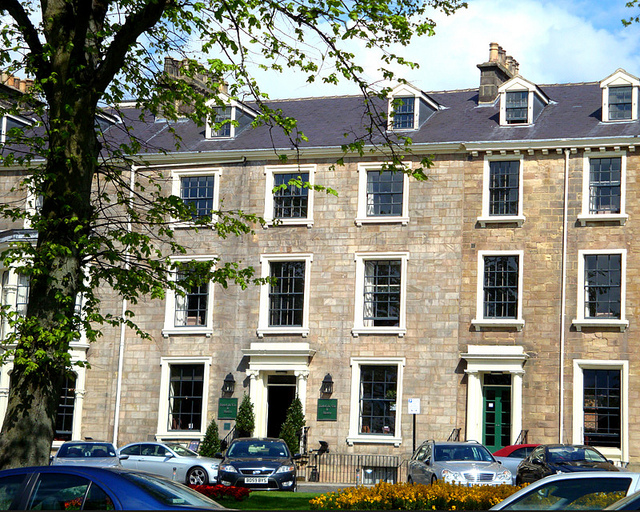The Hotel du Vin Harrogate is a town house that was created from eight Georgian-style properties…
Exploring Harrogate

From Harrogate town centre through Valley Gardens to Harlow Carr Gardens
4 miles (6.4kms)
About the walk
Harrogate’s civic motto is ‘Arx celebris fontibus’, usually translated as ‘a citadel famous for its springs’. This is very apt for the most important spa town in northern England, and one of the most famous in the whole country. Before the discovery of the health-giving waters, Harrogate was of minor importance compared to nearby Knaresborough, which was mentioned in the Domesday Book and was a market town from the 12th century onwards. The two small villages of Low and High Harrogate attracted little attention until 1571, when the first mineral well was identified. This, the chalybeate (iron-rich) Tewit Well, lies on the land now known as the Stray in High Harrogate.
Visitors began to come in numbers after the publication of Spadacrene Anglica or, The English Spa Fountain, by Edmund Deane of York, in 1626. Sulphur-rich wells were also discovered and a number of inns were built. The spas continued to be a mainstay of Harrogate’s economy for over a century, but decline set in during the 1960s. With large numbers of hotel beds to fill, Harrogate rebranded itself and is now one of the largest conference and exhibition centres in the UK.
Harrogate’s Valley Gardens were laid out in stages during the second half of the 19th century. They centre on the area known as Bogs Field, where no fewer than 36 mineral springs have been identified; no two are exactly alike, creating a diversity unique in the world. The formal gardens lead on to the Pinewoods, which feel wild by comparison. Come here early in the day and walk quietly, and you may spot a fox or roe deer.
The gardens at Harlow Carr also owe their development to sulphur springs. A bath-house and hotel (now the Harrogate Arms) were built in the 1840s. The gardens were acquired by the Northern Horticultural Society and opened as a botanical garden in 1950, principally to study the viability of plants in this northern, elevated site. Geoffrey Smith, famous from BBC radio’s Gardener’s Question Time, was Superintendent of Harlow Carr from 1954 to 1974.
The Northern Horticultural Society amalgamated with the Royal Horticultural Society in 2001. The six well-heads by the bath-house (now a study centre) have long been capped off but remain under the limestone rock garden, and it’s said that the smell of sulphur can still be quite distinct in this area, especially on still days.
You’ll encounter rocky outcrops of millstone grit as you enter the mixed evergreen and deciduous woodland, which clings to the steep hillside above the Oak Beck. This is one of only two places in Britain where you might see the chestnut click beetle (anostirus castaneus), which makes a loud clicking noise when it jumps. The beetle is orange-brown, with golden hair behind its head, a black tip to its body and feathered antennae-like stags’ antlers.
Walk directions
From Level 10 of the car park follow the covered walkway to Victoria Gardens Shopping Centre. Descend to street level and exit on to Cambridge Street and turn left. To reach Cambridge Street from the bus station, turn left along Station Parade and then right; from the railway station, turn right then left.
Cambridge Street opens into a square. Cross a zebra crossing, pass right of the war memorial, and cross another crossing and go down the street ahead, just left of Betty’s Tea Room. At the bottom follow the pavement round right to another zebra crossing and walk in front of the Crown Hotel.
Pass the Royal Pump Room Museum, then cross another zebra-crossing to the entrance of Valley Gardens. Enter the gardens and keep left on the lowest path, which runs beside a small stream. Follow this to the Magnesia Well Café and the area known as Bogs Field, which has an oval of flower beds around a fountain.
From the far end of the oval take another path through a ring of benches and pass right of the tennis courts. Pass the start of a Link Trail to the Dales Way, a mini-golf course on the left and a bowling green on the right. Pass a signpost for Pinewoods, Birk Crag, RHS Harlow Carr.
At the next signpost bear right by a Pinewood map board, with a war memorial to your right. Follow the path through the woods to a road.
Cross and go straight ahead through more woods and past an open area on the left. The path then runs along the edge of the wood, with fields and fine open views on the right. Pass a pair of binoculars on a stand and a panorama indicator. Continue straight ahead, descending now to a road. (To visit Harlow Carr gardens, turn left to the entrance.)
Turn right. Where the metalled track ends continue ahead along the track. After it bends right, go left on a signed footpath, then bear right to take the higher path. Drop down through rocky outcrops. Follow the path through the woods, always taking the higher path when there is a choice. The path reaches a gate leading to a road.
Turn left, then take the second road on the right, at a Ringway footpath sign. This unmade road eventually becomes a metalled road. After 0.75 miles (1.2km) turn right on Kent Avenue, then left by St Wilfrid’s Church onto Duchy Road. Take the next right, Clarence Drive, crossing York Road, to a T-junction. Go straight across though a gateway into the Valley Gardens. Turn left through the Pergola back to the entrance. Then retrace your steps back to the car park or bus station.
Additional information
Streets, tarmac paths and good woodland paths, no stiles
Town, park and woodland with some open views
Well-behaved dogs may be off the lead in the Pinewoods
OS Explorer 289 Leeds or 297 Lower Wharfedale & Washburn Valley
Victoria multi-storey car park, east side of the station
Victoria car park and Valley Gardens
WALKING IN SAFETY
Read our tips to look after yourself and the environment when following this walk.
Find out more
Also in the area
About the area
Discover North Yorkshire
North Yorkshire, with its two National Parks and two designated Areas of Outstanding Natural Beauty, is England’s largest county and one of the most rural. This is prime walking country, from the heather-clad heights of the North York Moors to the limestone country that is so typical of the Yorkshire Dales – a place of contrasts and discoveries, of history and legend.
The coastline offers its own treasures, from the fishing villages of Staithes and Robin Hood Bay to Scarborough, one time Regency spa and Victorian bathing resort. In the 1890s, the quaint but bustling town of Whitby provided inspiration for Bram Stoker, who set much of his novel, Dracula, in the town. Wizarding enthusiasts head to the village of Goathland, which is the setting for the Hogwarts Express stop at Hogsmeade station in the Harry Potter films.
York is a city of immense historical significance. It was capital of the British province under the Romans in AD 71, a Viking settlement in the 10th century, and in the Middle Ages its prosperity depended on the wool trade. Its city walls date from the 14th century and are among the finest in Europe. However, the gothic Minster, built between 1220 and 1470, is York’s crowning glory.
Nearby stays
Restaurants and Pubs
Nearby experiences
Recommended things to do
Why choose Rated Trips?
Your trusted guide to rated places across the UK
The best coverage
Discover more than 15,000 professionally rated places to stay, eat and visit from across the UK and Ireland.
Quality assured
Choose a place to stay safe in the knowledge that it has been expertly assessed by trained assessors.
Plan your next trip
Search by location or the type of place you're visiting to find your next ideal holiday experience.
Travel inspiration
Read our articles, city guides and recommended things to do for inspiration. We're here to help you explore the UK.













